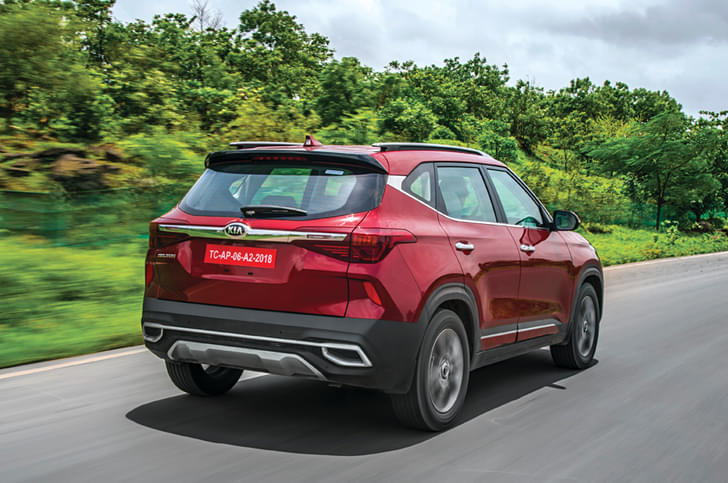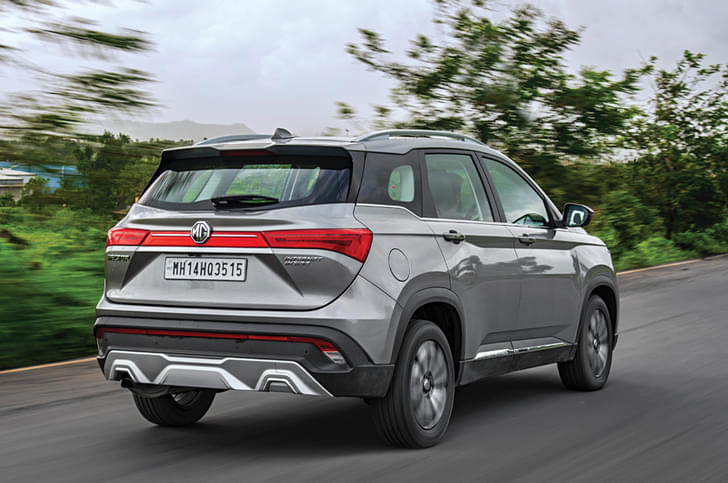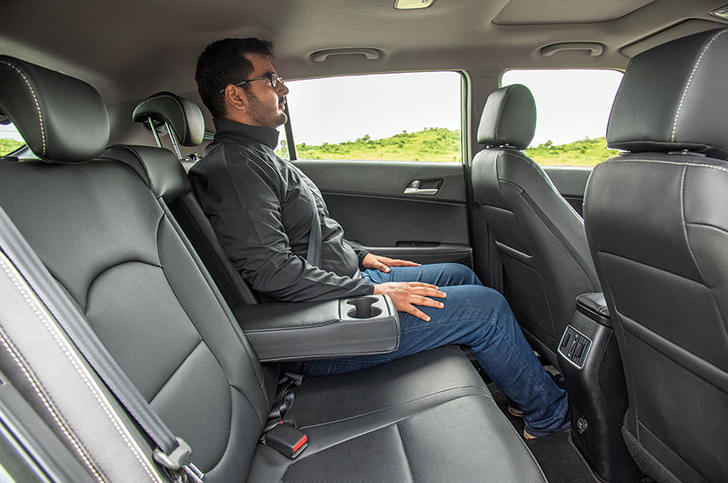We said in our first drive of this Grand i10 Nios that it was quite refreshing to see a new hatchback after a long spell of nothing but crossovers and SUVs, and now that we’ve brought in its two main rivals for a comparison test, I’m reminded of why we like them so much. When you think about it, these cars offer not much less by way of practicality, comfort and features than most sub-four-metre ‘SUVs’, and if anything, they’re more fun to drive and, not to mention, cheaper. So, let’s size them up, shall we? The Grand i10 Nios – longer in name, not that much bigger in size, but with a more upmarket interior. The Figo – the quintessential driver’s choice, the oldest of this bunch generationally, but with a few tricks up its sleeve yet. And finally, the Swift – which, for some reason, Maruti says is not a rival for the Nios (we beg to differ) – is the one to beat on the sales charts. Though it’s not quite the firecracker its forebears were, is still a force to be reckoned with.
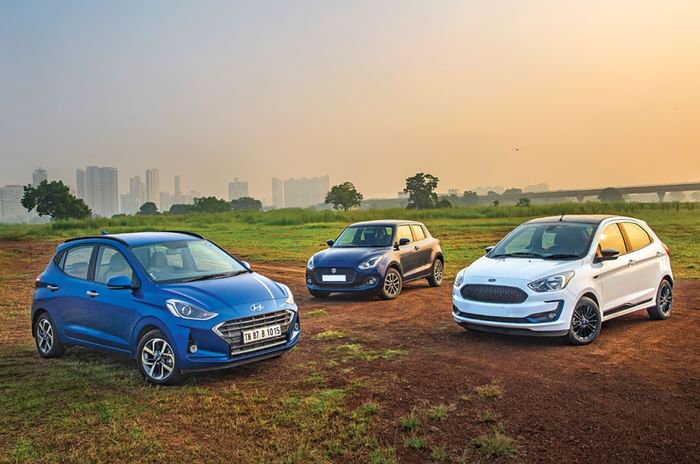
Feel-Good Factor
One of Hyundai’s perennial strengths has always been its interiors, and that’s true here too. The Nios interior feels really special, with rich plastics (for the most part; you’ll still find the odd basic bit) and a design that just wows you with its myriad colours and textures. Though the light shade looks like it might catch stains pretty soon, there’s no doubt it gives a premium feel. Things I particularly like are the rotary air vents, the big binnacle that houses the touchscreen and instrument cluster (though it cuts into your view forward slightly) and the rich fabric upholstery. In true Hyundai ‘tall boy’ fashion, you’re sat quite high up in the driver’s seat.

The view forward from the Swift’s driver’s seat is of a pair of racy hooded dials seen through the rim of a flat-bottom steering wheel, and if your view out is impeded, it’s because you’re meant to sit low for that sporty feel (there’s height adjust on all these cars, of course). The dashboard is wide and raked back with an all-black theme, with only a few grey accents livening it up. The seats are wide (though a bit soft) and have generous side bolstering to hold you in place. Plastic quality is good, but at the same time there’s nothing in here that wows you.
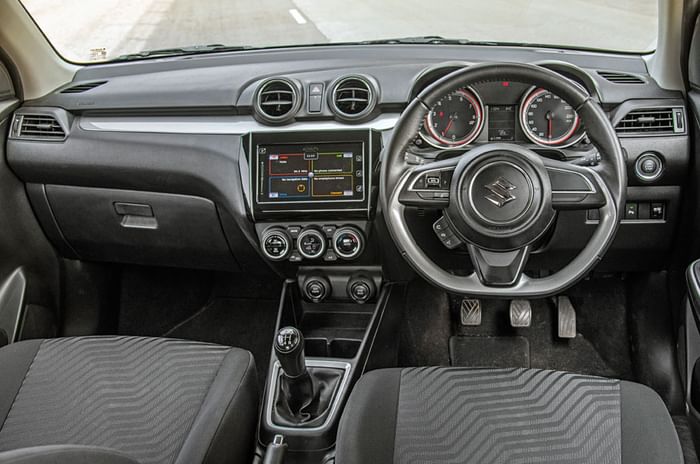
The Figo, too, has an all-black interior, but in this range-topping Titanium Blu variant, there are
neat blue accents and touches of chrome to liven things up. The driving position here is sporty too, with a compact, chunky steering wheel, though the seat isn’t quite as supportive or accommodating as the Swift’s. I like how they’ve integrated a touchscreen into the dash with the facelift where there wasn’t one before, and that there’s a nice shelf for a mobile phone in the dashboard. But you can’t escape a number of scratchy plastics in the cabin, and the fact that this interior feels quite dated now. The instrument cluster, especially, looks a generation behind.
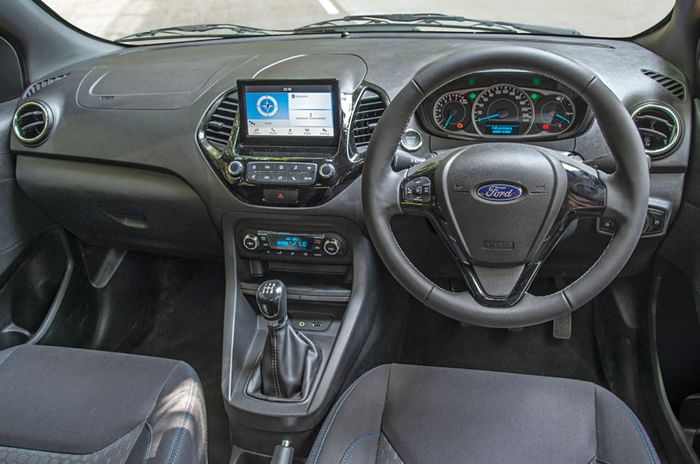
Family Friendly
Get past the look and feel though, the Figo does at least have a pretty spacious interior. The back seat can seat three abreast and though it seems a bit flat, it does offer good support. However, there are no storage bins in the rear doors, and while it does have enough space, the other two simply offer more. The Swift feels the widest in this test, and it does offer a bit more knee room than the Figo. The small windows, made worse by the lack of a quarter glass (blame that fancy, high-mounted exterior door handle on the C-pillar) however, do make things feel a bit claustrophobic in the back. The bench doesn’t offer a lot of thigh support either. Amazingly, for what is the smallest car on the outside, the Nios feels the most spacious in the back. If there’s a criticism, it’s perhaps that the backrest angle is a bit too heavily raked, but that’s down to personal preference. It offers up the most knee- and headroom of the three, its light colours and big windows give a great sense of space, the bench has good thigh support and the door pockets are the largest. And the icing on the cake? A set of rear AC vents, which the other two don’t have. It even has a big boot, with 260 litres, although the other two aren’t too far off – the Figo has 257 litres and the Swift has 268 litres. All three cars have slightly tall loading lips, but the Ford’s boot opening comes across as particularly narrow as well.
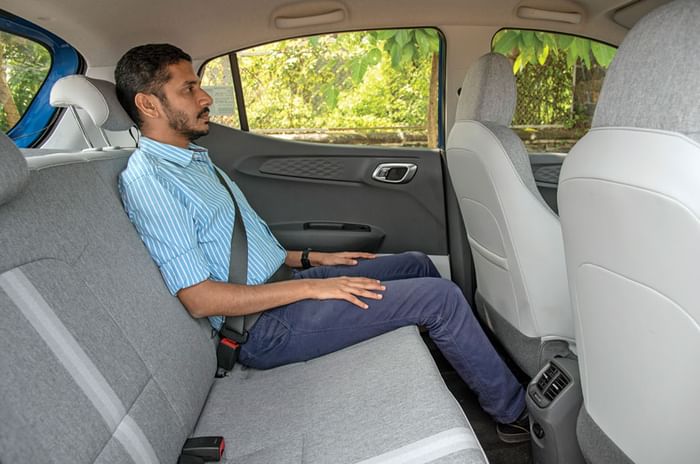
Tricks Or Treats
Apart from interior design and quality, Hyundais have always been known for their long and class-leading equipment lists. However, you get the sense that the boundaries have already been pushed to their limit for this segment by the previous Grand i10, and there’s only so much further a car can go at this price. Moreover, rivals have caught up on the equipment front, and now all three cars offer something useful and unique. You can see the exhaustive list in the table, but here’s what sets each of these cars apart.
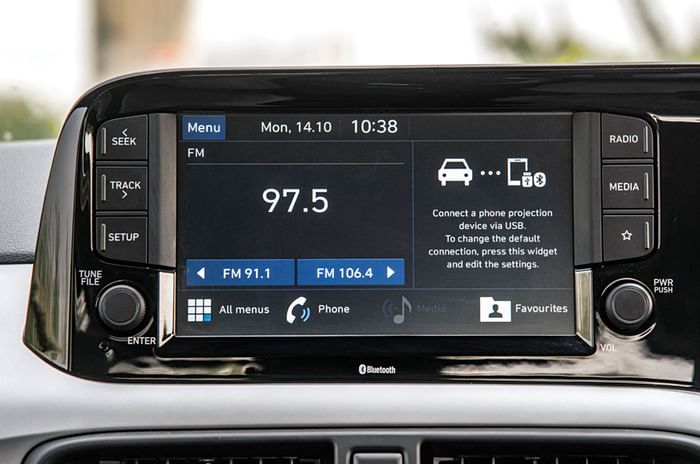
The Figo is the only car here with six airbags and an auto-dimming rear-view mirror, and it also gets the advantage of automatic wipers. It is, however, the only car here to miss out on Android Auto and Apple CarPlay in its touchscreen infotainment system, which feels like a significant omission, especially since its siblings the Aspire and Freestyle do get it. The Swift, meanwhile, is the only one with full-LED headlamps and a rear seat that can be split 60:40 before it folds. At 8.0 inches, the Grand i10’s touchscreen is the largest here, and though it doesn’t have the connected tech of its bigger sibling, the Venue, it’s Hyundai’s latest operating system – the most functional and feature-loaded in this test. You also uniquely get a wireless mobile phone charger, rear AC vents, and a digital rear-view mirror (the rear-view camera feed can be displayed permanently on screen). What you do miss in the Hyundai, which the others get, is automatic headlamps.
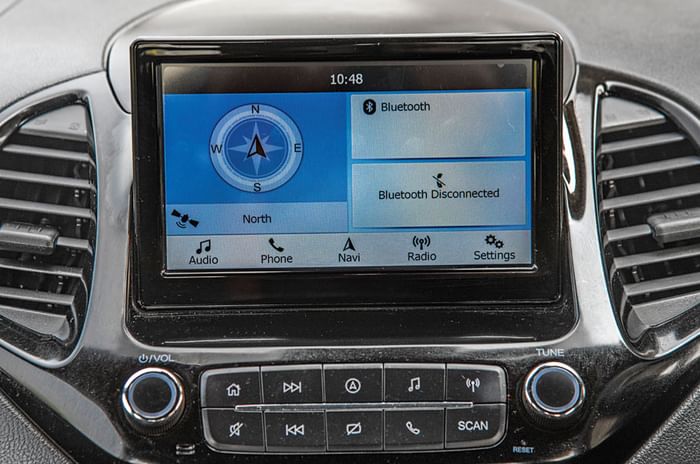
| What you get for your money | |||
|---|---|---|---|
| Hyundai Grand i10 Nios Asta MT | Maruti Suzuki Swift ZXi+ MT | Ford Figo Titanium Plus MT | |
| Projector headlamps | Halogen | LED | No |
| LED DRLs | Yes | Yes | No |
| Keyless entry and go | Yes | Yes | Yes |
| Auto headlamps | No | Yes | Yes |
| Auto wipers | No | No | Yes |
| Auto climate control | Yes | Yes | Yes |
| Auto-dimming inside mirror | No | No | Yes |
| Rear AC vent | Yes | No | No |
| Touchscreen | 8.0-inch | 7.0-inch | 7.0-inch |
| Apple CarPlay/ Android Auto | Yes | Yes | No |
| Rear-view camera | Yes | Yes | Yes |
| Rear parking sensors | Yes | Yes | Yes |
| Wireless phone charger | Yes | No | No |
| ABS | Yes | Yes | Yes |
| Airbags | 2 | 2 | 6 |
Motive Force
When it comes to the engines, all three use 1.2-litre petrols – the Nios and Swift’s each having four cylinders, and the Figo sporting three. The big difference is that Maruti and Hyundai have upgraded their engines to BS6 emissions standards, while the Ford is still BS4 compliant, with the upgrade due closer to the April 2020 deadline. However, while the Hyundai and Maruti make an identical 83hp, the Figo makes a solid 96hp! The torque ratings are a little closer stacked, with the Grand i10 making 114Nm, the Swift 113Nm and the Figo 120Nm. But then the Swift’s bantamweight 885kg kerb weight brings its power to weight ratio quite close to the Figo’s.
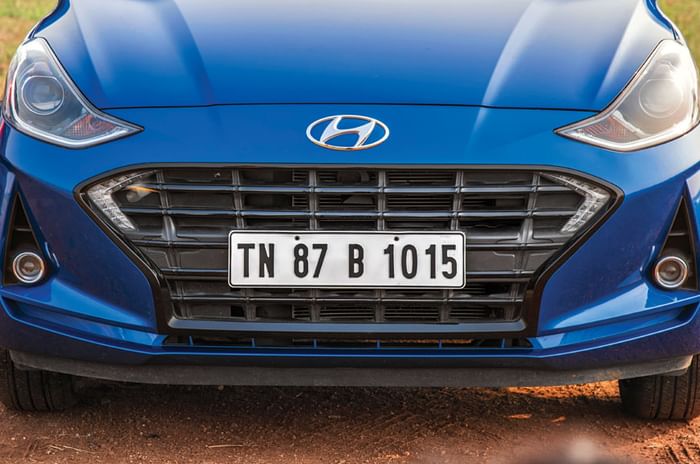
Hyundai’s Kappa2 engine already wasn’t the most potent of its kind in BS4 guise, and even more of its pep seems to have been sapped in BS6 guise. Not helping matters is the Grand i10’s tall gearing, likely done in the interest of fuel economy. Performance, as a result, is merely adequate, and there’s a distinct lack of enthusiasm off the line, and even more so through the gears. You’re more inclined to rev it to pick up some pace, but once you get to around 3,000rpm, it gets quite vocal, and it’s not the nicest sound either.
| Specifications | |||
|---|---|---|---|
| Hyundai Grand i10 Nios | Maruti Suzuki Swift | Ford Figo | |
| L/W/H | 3805/1680/1520mm | 3840/1735/1530mm | 3941/1704/1525mm |
| Wheelbase | 2450mm | 2450mm | 2490mm |
| Tyre size | 175/60 R15 | 185/65 R15 | 195/55 R15 |
| Engine | 4-cyls, 1197cc, petrol | 4-cyls, 1197cc, petrol | 3-cyls, 1194cc, petrol |
| Power | 83hp at 6000rpm | 83hp at 6000rpm | 96hp at 6500rpm |
| Torque | 114Nm at 4000rpm | 113Nm at 4200rpm | 120Nm at 4250rpm |
| Gearbox | 5-speed manual | 5-speed manual | 5-speed manual |
After the really impressive 1.5-litre ‘Dragon’ engine in the EcoSport (not to mention several impressive Ford petrol engines of the past), the Figo’s 1.2-litre petrol feels like a bit of a letdown. This is particularly true at low speeds where, like the Nios, there’s a distinct lack of pep, which means you’ll find yourself doing a lot of gear-shifting when moving around the city. However, once you get it into the mid-range and beyond, it wakes up quite nicely and feels quite eager. And you’ll want to rev it too, because it makes a pleasing three-cylinder sound. The result is, if you really wring it out on a nice road, you could have an absolute blast in the Figo, but in more mundane driving conditions, it feels a bit sluggish.
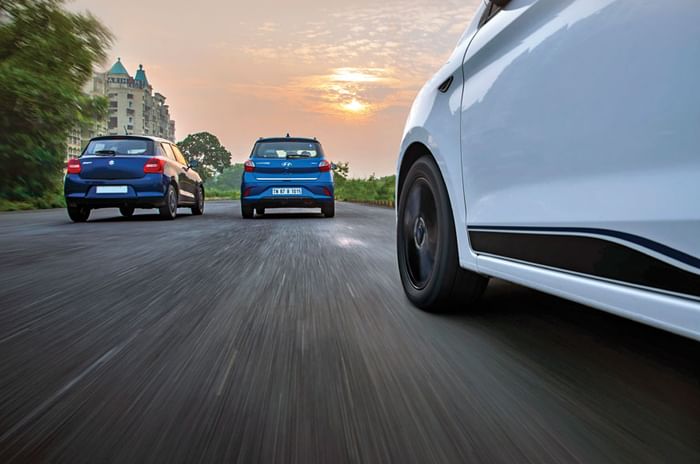
| Performance | |||
|---|---|---|---|
| Hyundai Grand i10 Nios | Maruti Suzuki Swift* | Ford Figo | |
| 0-20kph | 1.14 sec | 1.27 sec | 1.28 sec |
| 0-40kph | 3.02 sec | 2.80 sec | 3.26 sec |
| 0-60kph | 5.75 sec | 5.34 sec | 5.74 sec |
| 0-80kph | 8.79 sec | 8.01 sec | 8.96 sec |
| 0-100kph | 13.28 sec | 12.34 sec | 13.80 sec |
| 20-80kph (in 3rd gear) | 14.00 sec | 13.06 sec | 14.93 sec |
| 40-100kph (in 4th gear) | 22.44 sec | 20.09 sec | 23.36 sec |
Getting A Handle
The Nios certainly doesn’t feel like being hurried through corners. In classic Hyundai fashion, it’s all about convenience and ease of driving. It starts with the tall-boy seating position and goes on to a light and lifeless steering, with lots of body roll through in the bends. The Nios is an improvement on previous i10s though; the steering does have a bit of artificial weight to it (at lower speeds) and it does return freely to centre.
This is something the Swift’s steering just does not do, which is a big blemish on an otherwise excellent handling package. Like all Swifts before it, this third-generation car has a well-sorted chassis, and though the suspension has gotten a little softer, composure and body control remain rather excellent. It’s just that your link to that chassis – the wheel – feels loose and disconnected at low speeds. It makes for good manoeuvrability and it does weigh up when you go faster, but the Swift is no longer the handler its forebears were.
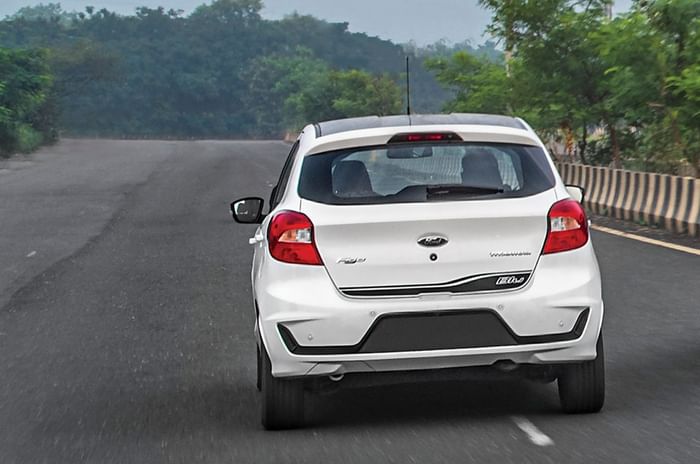
The Figo – now that’s a fun handling car! The steering is quick, millimetre-accurate and a great conduit of information between the front wheels and your fingertips. Then there’s the chassis, which combines the comfort of the pre-facelift Figo with some of the clever suspension tuning of the erstwhile Figo Sports Edition. It’s just an absolute joy to fling around a series of corners. The steering doesn’t even feel heavy at lower speeds, so at no point does it leave you feeling like you have to work it around traffic.
The best part is that ride hasn’t been compromised in the Figo either; it feels comfortable and stable at just about all speeds. To its credit, so does the Swift, which as I said earlier, is also very well judged. The Grand i10, particularly this petrol version, is softly sprung, and so you might get some low-frequency float over an undulating road, but at low speeds, it’s really comfortable.
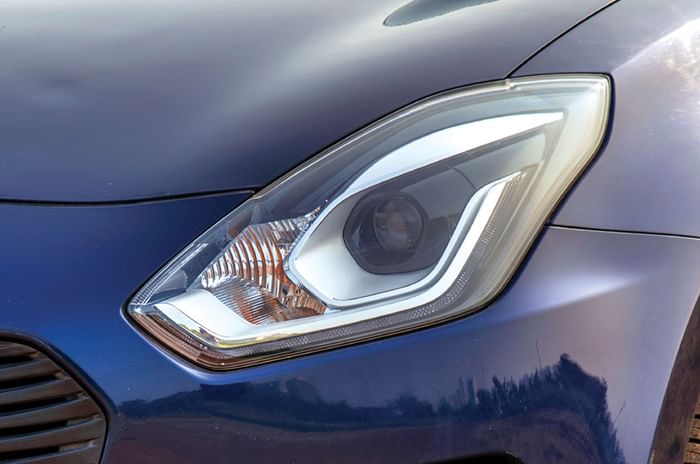
Pocketful Of Sunshine
Small, nimble, premium, affordable, practical do-it-alls is what these three cars are. Fun also plays a part, and you may recall the Figo won our fun-to-drive hatchback comparison when it was new. If that was the priority of this test, it would still win despite that engine, because no matter what, the Ford remains the driver’s choice. It helps that, at Rs 6.65 lakh (ex-showroom), it’s also the most affordable here. It compromises in places such as space and practicality that let it down in its role as the family hatchback, and the fact it’s showing its age now.
The Swift remains a great family car and does still have a hint of fun to the way it drives – it’s certainly got the strongest engine. Also, though styling can be subjective, I personally like the way it looks best of these three. In fact, on the whole, there’s not a lot to fault with the Swift, apart from perhaps its price, which at Rs 7.53 lakh, is the highest of this trio.
It’s just that the Grand i10 Nios does most things a little bit better. It’s not geared for fun driving and it’s got a weak powertrain, but as a city car, it’s quite excellent. It’s got the edge on the others on space, it’s got a modern-looking interior and an impressive equipment list. But most of all, it feels premium and inviting, like your money (a reasonable Rs 7.14 lakh in this top-spec Asta guise) has really gone far, and this is something it definitely does better than the other two.
In today’s world of SUV this and crossover that, the quintessential family hatchback has to work hard to win you over, and the Grand i10 Nios does this effortlessly.
| Verdict | |||
|---|---|---|---|
| Hyundai Grand i10 Nios | Maruti Suzuki Swift | Ford Figo | |
| Price (ex-showroom, Delhi) | Rs 7.14 lakh | Rs 7.53 lakh | Rs 6.65 lakh |
| Rating | 8/10 | 8/10 | 8/10 |
| Verdict | Big on space, easy to drive, and feels very upmarket. | Strong engine and a good all-rounder but expensive. | Incredible fun to drive and good value but feels dated. |













